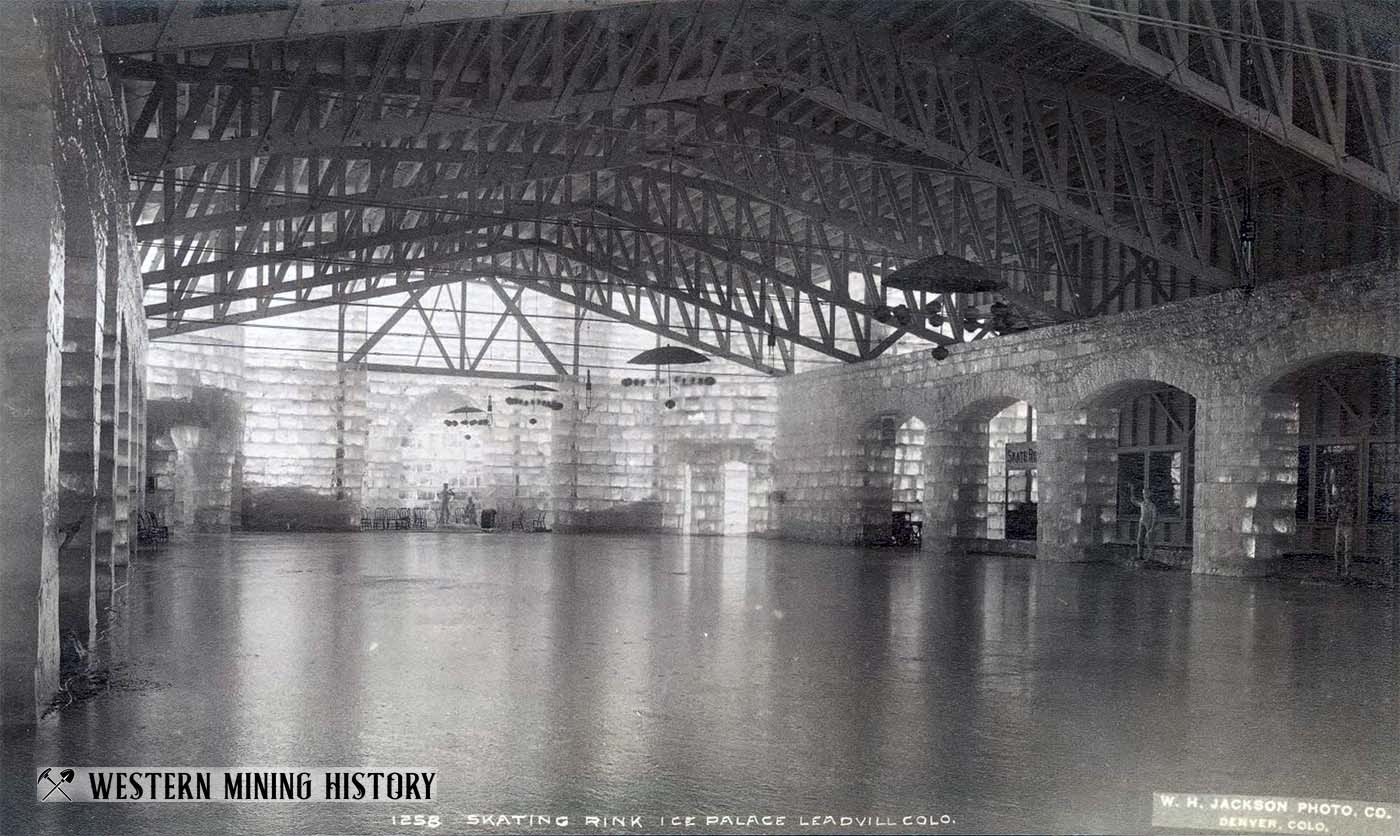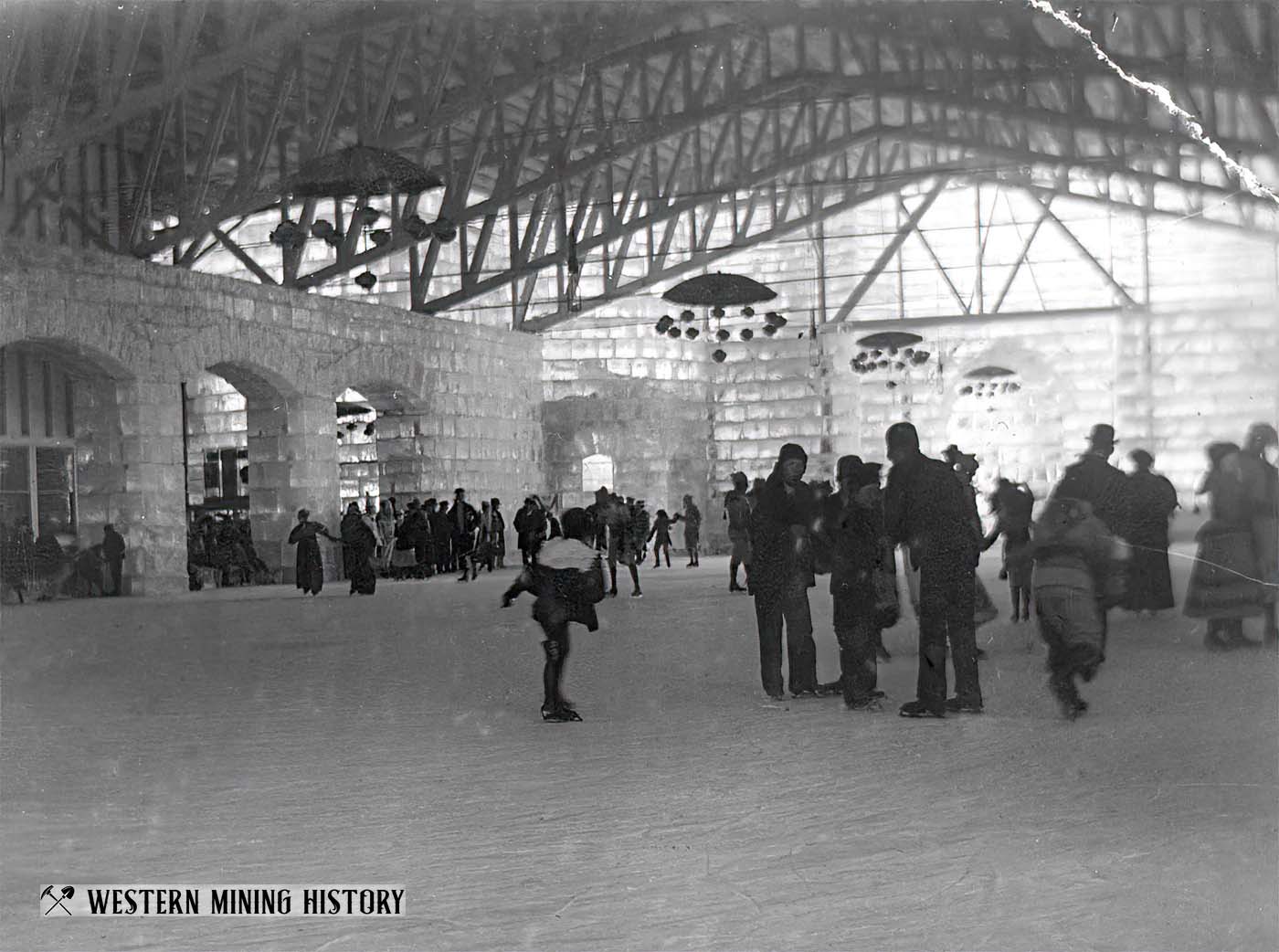by Jan MacKell Collins
For the mostly mining population of Leadville, the splendidly grand Leadville Ice Palace was a fantasy come true.
Although Leadville was at one time the largest boomtown in Colorado, the mines were in decline by the 1890s, which was made worse by the repeal of the Sherman Silver Purchase Act in 1893. Leadville’s population of 40,000 suddenly dwindled to less than half of that number by 1895.
That August, Edwin Senior, a local real estate developer, presented an idea to Leadville’s city council. Why not host a huge winter carnival, accented with a big palace made entirely of ice?

Leadville would have plenty of ice come winter, Senior explained, and besides, such mega structures had been a great success in Montreal, Canada, and St. Paul, Minnesota. Not only would the undertaking create much-needed jobs, but tourists who came to see it would be spending money at the local hotels, restaurants and other places.
A great deal of discussion about the idea went on for several weeks as donations and support were solicited for the project. In September, a meeting was held at the Tabor Opera House to form a fundraising committee, spurred by $2,500 in donations already in place.

They called the idea “The Crystal Carnival at the Ice Palace.” Senior, as business manager, busied himself canvassing Leadville for support, soliciting donations, and answering questions from reporters and the public.
By early October, a viable site had been selected. The spot was on a hillside in Block 53, between West 7th and West 8th Streets, where it would be visible from downtown. The land was owned by Lake County, and the committee leased it for five years at a dollar per year in hopes that the carnival would become an annual event.

Unfortunately, Edwin Senior might have been great at ideas, but not so much at raising money. Donations were lacking, and towards the end of October Mr. Tingley Wood was nominated as a replacement. Senior acquiesced and resigned as the plans moved forward.
Architect Charles E. Jay, who previously designed the ice palace in St. Paul, was hired to draw up plans for the Ice Palace. The Leadville Crystal Carnival Association was incorporated on November 7 as multiple designs and attractions were discussed.

Amazingly, the fundraising had nearly reached its $20,000 goal by the time Mr. Jay arrived later that day. As he got situated, the site was being prepared. The sounds of dynamite blasts reverberated throughout the city as stumps, boulders and other debris were blown out of the way.
Architect Jay’s plans were amazing. The Ice Palace measured 450’ long by 320’ wide, with five-foot thick walls. Two octagonal towers rose 90 feet at the entrance on the north, where beautifully arched doorways led visitors inside. Smaller, 60 foot towers flanked the sides and the south wall. Inside,

Jay designed a skating rink that would accommodate 1,000 skaters, two beautiful ballrooms, and a restaurant. A 20-foot wide promenade would lead people down the middle of the place. Aside from the wooden supports forming a skeleton from which to work, the entire building would be made of ice. All materials would come from Leadville suppliers.
As plans were firmed up, over 250 men were employed to build the Ice Palace. Meanwhile, city officials wisely conferred with St. Paul officials about what sorts of events would ensure success. On November 15, a parade was held as official construction neared commencement. Ten days later, the cornerstone (of ice, of course) was laid.

Constructing a building of ice was different than any other. The blocks had to be shaved and shaped for continuity. Each finished wall was sprayed with water to freeze the blocks in place. When the Leadville Ice Company began running short, additional blocks were hauled in from nearby Evergreen Lakes, and as far away as Palmer Lake on the front range.
Work continued thorough December as electric lights were attached to the ceilings. Behind the scenes, sculptors worked meticulously to create pieces of art entirely made from ice.

Leadville was now alive and buzzing with anticipation as everyone prepared for the thousands of people who were sure to visit. More hotels went up. Restaurants and shops nearly went into debt stocking up extra food and supplies. Ice Palace souvenirs were made.
When donations ran low, newspapers solicited more money, and got it. Never had anybody prayed so hard in their lives for continued dipping temperatures, and Leadville’s Christmas was the happiest in years.

Finally, on December 31st, the Leadville Ice Palace was ready to receive the public. So hauntingly beautiful was the finished structure that the Salida Mail called it “that frozen poem in Leadville.” On opening day, January first, 2,500 visitors came by train, wagon, horseback and on foot to see the gigantic wonder.
The Crystal Palace and Carnival was in full swing, with exhibits, including flowers and native animals frozen into ice blocks. In the restaurant, guests could view what was on the menu by looking at prepared meals that also were frozen in ice. There were carpeted reception rooms with fine furnishings.

The ballrooms, as well as dressing rooms with maids and valets, were heated. There were cigars and candy. Photographs, and souvenirs. Dances. Competitions. It was all there, for all to enjoy.
For nearly four glorious months, visitors paid .50 cents for adults and .25 cents per child to walk past the gorgeous ice sculpture of “Lady Leadville” at the entrance, and into the fantasy of their dreams.

They enjoyed the frozen art pieces, listened and danced to the bands on the balconies, and admired the unique displays advertising Leadville’s hotels, newspapers, railroads and shops. They attended the small theater, and the men took full advantage of the gaming rooms with their games of chance.
Children rode the merry-go-round. At night, colored lights illuminated the Ice Palace to make it look like something right out of a fairy tale.
It is estimated that the number of visitors to the Ice Palace numbered over 250,000. Thanks to discounted railroad tickets and special days for groups like the Shriners, the Colorado Press and others, there was always a crowd.

Fireworks shows, hockey tournaments and rock-drilling contests were highly attended. And amazingly, the sometimes feisty citizenry of Leadville behaved themselves—perhaps because they were warned early on to settle their differences off of the Ice Palace grounds.
Even so, there were a few incidents. One of them concerned Madam Laura Evens of Salida, who was just a young Leadville harlot when she and her friend, Etta Murphy, dared to steer their horse-driven sleigh into the Ice Palace. According to Laura, the horse “got scared at the music and kicked the hell out of our sleigh and broke the shafts and ran away and kicked one of the 4 X 4′ ice pillars all to pieces and ruined the exhibits before he ran home to his stable.” That incident didn’t make the papers. Two boys who were arrested for stealing tools did.

Added to the very rare incidents at the Ice Palace was the dissatisfaction of the local business owners. Visitors coming by train often only stayed for a day, and some brought their own lunch pail.
Rumors were circulating that the structure was melting, or the walls were in danger of falling. They said pick pockets were running amok and there wasn’t enough for visitors to eat. These fibs were squelched by the promoters, but the truth of the matter was, the cost of running the Crystal Carnival was more than they thought it would be.

To some, it might have brought a bit of relief when, during the ever-fickle month of March, several unseasonably warm days spelled the end of the Leadville Ice Palace. As word spread that the magnificent building really was melting, attendance took a dramatic downswing.
The city managed to keep the Ice Palace open until March 28th, when one last ceremony closed it for good. When the many investors and promoters tallied up the proceeds for the whole affair, they found that a significant amount of money had been lost.

As the Ice Palace melted during the coming months, only the ice rink remained in use. The final skating party on May Day was well attended. Although there was talk of resurrecting the Ice Palace in the following years, never again did the plan come to fruition.
At least the wooden building supports came in handy during a miner’s strike in June: In September the Colorado State Militia sent their soldiers to keep things calm, and used the defunct building’s remaining materials to build a barracks for them. After they left, everything else was dismantled, and the beautiful Leadville Ice Palace officially became a memory.

Leadville: Colorado’s Magic City
The Ice Palace was only one small part of the amazing history of Leadville, Colorado. The great mining rush to this location that started in 1879 dramatically altered the mining landscape of Colorado, and almost overnight Leadville became the state’s most important city.
For more photos and history of this amazing western mining city, visit the Leadville, Colorado page.
